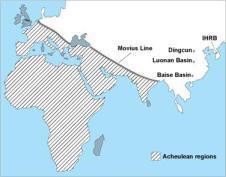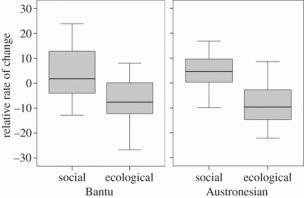In 1492 Columbus sailed the ocean blue. But why wasn’t there a Native American explorer sailing in the opposite direction? 35,000 years before all that modern humans arrived in ice age Europe, where they promptly developed excellent cold weather clothing; something the Neanderthals don’t seem to have done despite living there for an order of magnitude longer! And 1.5 million years before that a group of Homo erectus appears to have forgotten (or maybe they never adopted) great new bifacial tools.

The shaded area represents the region where Homo erectus made fancy tools. Apparently they just gave up on them half way round the world.
Human culture, it would seem, doesn’t change in a consistent or even predictable way. Whats up with that?
Obviously the answer to this question has some pretty profound implications for our species, our history and our future. So it should come as no surprise there’s an awful lot of speculation on the subject. Some think the answer might be demographics. If x% of the population are innovative geniuses, larger groups will develop new tools at a faster rate1. Other think the environment might hold the key, noting how groups in harsher environments tend to have more complex tools because the cost of failure is so high2. Jared Diamond (in)famously argued that latitude was responsible. Environments on the same latitude tend to be more similar, allowing innovation to spread rapidly west/east, but much slower north/south3.
However, these ideas have been criticised for being overly deterministic and/or reductionist. The idea that the vast diversity of human culture can be explained by some formula based on environment and population makes people uneasy. What about the desires of the people involved, the traditions of the cultures themselves. Might they not influence how it all changes?
Whilst many of these critiques are a bit to liberal arts for my liking (scientism for life) they do raise a good point. All of the aforementioned hypotheses are based on the same assumption: that all else being equal cultures would change at the same rate in a similar way. If aliens came and mixed around humans 10,000 years ago we should still see broadly similar technological and cultural maps. Yet despite being the underlying assumption of pretty much all research into this issue it is rarely directly tested. We could be barking up the completely wrong tree.
This seems like a pretty major oversight, so it’s fortunate that a pair of researchers from the UK recently tried to rectify it. First, they examined almost 30 cultural traits (e.g. acceptance of slavery, segregation of children etc.) in Pacific Islander and Sub-Saharan African groups to see how they varied. Then they looked at the language differences between the groups in these regions to estimate how much time they had been separate and in which order they split up. Based on this they had a rough idea of how it took for all those cultural differences to arise, giving them a figure for the rate at which cultures change. It’s kinda like how you can compare the genes of different species to figure out how long they’ve been apart. Except with slavery, which is far less fun4.

The different cultural traits varied at a similar rate in both regions. In both cases, social traits also tended to change faster than ones related tot he environment
Their results were not able to identify which factors influence the rate of cultural change, but they did confirm that something is responsible. In both populations the same cultural traits were found to be the most malleable. Inheritance laws for these groups, for example, changed frequently whilst they layout of camps would change at a much slower rate. This relative consistency indicates that these cultural traits are being influenced by the same set of predictable phenomena. In other words, the study of the evolution of human culture is possible and we haven’t been wasting our time on the subject4.
So evolutionary anthropology isn’t a hopeless field. And the fact I haven’t wasted my life is very happy, and you should all be happy this blog isn’t wasting your time either. Science can solve these problems! Eventually. With more data. And time. And funding.
Plz give it to me.
References
- Henrich, J. (2004). Demography and cultural evolution: how adaptive cultural processes can produce maladaptive losses: the Tasmanian case. American Antiquity, 197-214.
- Oswalt W. H. 1976 An anthropological analysis of food-getting technology. New York, NY: Wiley
- Diamond, J. M., & Ordunio, D. (2005). Guns, germs, and steel. National Geographic.
- Currie, T. E., & Mace, R. (2014). Evolution of cultural traits occurs at similar relative rates in different world regions. Proceedings of the Royal Society B: Biological Sciences, 281(1795), 20141622.

